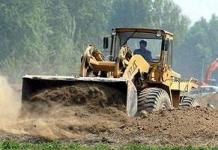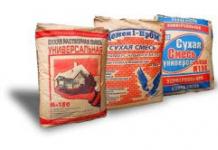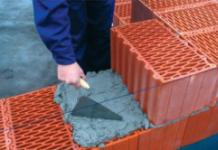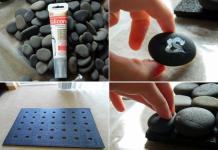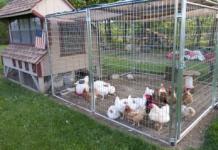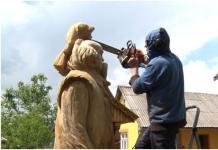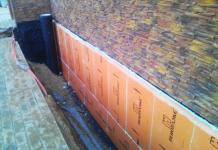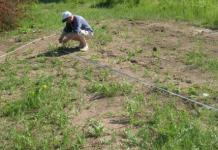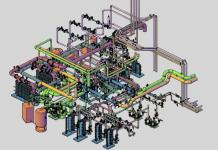As a rule, the need to level the site arises when buying completely new, previously uninhabited land plots. Various social programs to a certain extent contribute to the growth of suburban construction.
Only now, for those plots that are allocated for individual development, gardening or other purposes, not a single administration will allocate land that is actively used as agricultural. Basically, these are wastelands located outside the boundaries of the settlement.
Even if you are lucky and the ground is relatively flat, you will still have to level individual segments of the territory - for the construction of a house, a sports or playground, a decorative lawn or something else. There are several methods, the complexity of which and the amount of work depend entirely on the size of the site and its features (for example, the degree of slope).
Consider the most effective and affordable ways to level the land, which are available for do-it-yourself work.

For minor elevation changes
Everything is pretty simple here. In order to make the alignment better, you need to divide the intended territory into separate areas (rectangles or squares, as it is more convenient). To do this, the site is marked with the help of milestones (wooden pegs, pieces of reinforcement), which are fixed in the ground at “nodal” points. Cords are stretched between them, which designate individual segments.
The reference point is the highest place on the marked area. If additional bedding is expected (for example, a fertile layer), then the cord rises by 4–5 cm.
This "grid" can be located either in a horizontal plane or at an angle. The latter option, as a rule, is not often used. For example, in areas where it is planned to equip a decorative lawn with a certain slope.
All the rest of the work consists in cutting the hillocks and filling in the recesses in other cells of the "grid" with this earth. In principle, it is needed only to visually make it easier to control the quality of alignment over the entire area. Therefore, the distances between the cords are chosen arbitrarily, depending on the initial state (roughness) of the soil.
If it is planned to use this site for planting plants (arranging beds, flower beds,), then it is advisable to cut off the top layer by about 8–10 cm in order to completely remove the entire grass root system. After that, the purchased fertile soil is added.
In some cases, leveling comes down to banal tamping of the soil. For example, for arranging paths. The simplest ice rink is easy to make yourself using a metal barrel, along the longitudinal axis of which a steel pipe is inserted. To give the rink the required weight, a solution of cement (concrete) is poured inside. Well, how to assemble such a device, no explanation is required.

With significant slopes
Option "No. 1
Much here depends on the steepness of such a slope and the future plans of the owner. Many people are not at all afraid of a large bias, on the contrary. For example, a decorative lawn on a slope, which looks great against the backdrop of a beautiful house, looks quite original and attractive. In this case, the general procedure is not much different from the one already indicated. The only difference is that the entire site will be tilted in one direction.
The only thing that will have to be taken into account is that not all representatives of the flora (from decorative ones) will be able to develop normally in such a site. Many of them are very demanding on its alignment, so the choice of vegetation will be somewhat limited.
Option number 2
 If the steepness of the slope is quite significant (more than 150), then it makes sense to arrange terraces. Their width and number are determined based on the overall design of the territory, as well as the purpose of the site.
If the steepness of the slope is quite significant (more than 150), then it makes sense to arrange terraces. Their width and number are determined based on the overall design of the territory, as well as the purpose of the site.
Initially, horizontal lines are marked (pegs + cord). The essence of the work is in cutting off a layer of earth on each designated tier to give it a complete "horizontal". Naturally, one should start from the bottom, gradually, stepwise, moving up the slope.
What to consider? The ends (sidewalls) of all "steps" need to be strengthened, otherwise the soil will gradually begin to crumble. The easiest, most effective and cheapest way is to strengthen them with gabions. What are they and how to make them.
By whatever method the leveling is carried out, at the end of the work it is necessary to shed the area abundantly with water. The soil will sag a little, and all the flaws will be visible. And pouring a little earth in some places is easy.

Approximate cost of work
Alignment activities are carried out, as a rule, in a complex. Therefore, the prices of specialized organizations providing such services are quite high. By region, they may vary, but on average they are:
- departure of an employee to survey the territory and consult the owner - from 2,600 to 4,100 rubles;
- uprooting of stumps, removal of trees (shrubs) and the like - from 500 rubles / piece;
- leveling the surface using special equipment - from 35 rubles / m².
Plus, this is the purchase of soil (if backfilling is necessary), transportation costs, loading / unloading. You may have to cut off part of it and take it out - this is another additional fee. There are enough nuances.
Land area calculator
Side A
m.
Side B
m.
Side C
m.
Side D
m.
Land area

For large areas intended for leveling, it is advisable to use the technique. But what is it? If you rent a bulldozer, the work will be done relatively quickly. But this machine will cut off part of the fertile layer, and damage part. Therefore, one way or another, you will have to buy land.
Therefore, when determining the cost of such leveling, it is necessary to sum up all the costs - for the use of equipment + the price of chernozem with delivery to the site. In addition, you will have to deal with its spreading over the site and additional leveling of the surface.
As a rule, private land plots for building or gardening do not exceed a few acres. If we are talking about a territory larger than 4 - 5, then it is better to use a cultivator (with the appropriate one). With this unit, alignment is also relatively fast, but much more accurate. The cost of renting a cultivator is on average from 1,400 rubles for 1 - 2 days. If the lease term is longer, then the final price is somewhat lower.

But in any case, for a private trader, this option is preferable to hiring heavy construction equipment. The peculiarity of the work is that it is advisable to make “driving” in perpendicular directions over the entire leveling area.
There are recommendations that the upper fertile layer should first be carefully cut off and set aside, so that later it can be used as a backfill. But how useful is such advice, because after laying the sod, weeds (and their root system will not go anywhere) will inevitably begin to sprout? In any case, no matter what is arranged in this territory - flower beds, lawns or beds - you will have to fight the grass. The question is - do the owners need extra trouble, and regular? It is more reasonable to do the backfilling with purchased black soil. Naturally, you will have to spend money on this, but in the future this solution will save you from many problems.
For final alignment, it is advisable to use a device that is easy to make yourself. In appearance - an ordinary wooden staircase. The only difference is that the steps protrude slightly beyond the sidewalls.
If it is dragged several times (by tying a rope) across the territory (back and forth), then it, like a large rake, will finally smooth out all the irregularities. Moreover, it does not have to be knocked together in the form of a rectangle. The configuration is selected based on the maximum convenience in operation.
For these purposes, a piece of rail, channel is also suitable. True, you will need an assistant to carry such a blank on 2 ropes around the territory.
You should not immediately start arranging the leveled area. As a rule, in any soil, even prepared for filling, there will be some remnants of weeds. It is better to wait until they germinate and finally clear the soil. This is more expedient than fighting them later, after the site has already been planted with something.
Even before starting work, it is necessary to consider how the drainage system will be equipped, since it is advisable to carry out all excavation work immediately. For example, in parallel with the alignment, lay pipes.
In this article we will look at how to level the site in the country. Learn how to check the level of the site. Let's take a look at the step-by-step instructions. Let's compare alignment in different ways.
The optimal platform for raising the foundation and fence, arranging a vegetable garden and a garden, as well as creating a lawn area and a pool area is a flat soil surface. Suitable for the construction of the above buildings and sites are areas with a slope of not more than two degrees. However, such land is a rarity.
You can level the site yourself, provided that the differences in the soil layer do not exceed 8-9 cm.Before proceeding with the leveling of the personal plot, it is necessary to determine the purpose of the plot, namely, to allocate separate zones, for example, for the construction of a pool, lawn, garden or vegetable garden.
Experts in the earthworks industry recommend that site owners coordinate their ideas with professional land surveyors who will help analyze the mechanical structure of the soil, as well as determine the exact location of groundwater.
 The land surveyor will help determine the slope of the relief and the direction of the runoff, as well as give recommendations on the arrangement and operation of the site, taking into account the structure of the soil and the level of groundwater.
The land surveyor will help determine the slope of the relief and the direction of the runoff, as well as give recommendations on the arrangement and operation of the site, taking into account the structure of the soil and the level of groundwater. An objective analysis of the site will allow you to properly distribute the site and highlight favorable areas for building a foundation, a pool, as well as for creating lawns and garden plots. Moreover, soil analysis will determine the height of the differences in the soil layer, which will help solve the issue of moving and adding soil. Since with large differences, the owner of the site will need to think over the delivery of soil in advance and provide for special equipment.
Step by step instructions for leveling the area under the lawn
The lawn, with dense grass covering an evenly allocated area, is an ideal place for family recreation, as well as a worthy decoration for creating any landscape composition.
An important condition for the arrangement of the lawn is a flat surface of the soil layer on the site. The lawn on a flat surface looks more aesthetically pleasing and attractive, successfully takes root and does not get wet after watering and precipitation, and also does not complicate the work of the lawn mower.
 On a flat surface of the site, the lawn is distinguished by splendor and density. In areas with drops, a lawn with bald spots is formed, since at the upper points of the soil layer the sown seeds are washed out with rains and move to the lowlands with the flow of rainwater.
On a flat surface of the site, the lawn is distinguished by splendor and density. In areas with drops, a lawn with bald spots is formed, since at the upper points of the soil layer the sown seeds are washed out with rains and move to the lowlands with the flow of rainwater. - Before leveling, the site is cleared of various debris and stones. Remove stumps, old shrubs and trees;
- After cleaning the site, remove the vegetative layer of soil (sod);
- A platform of average height is identified, which will serve as a reference point when leveling the site. If the plans raise the surface of the site, then the highest point is taken, from which it will be necessary to build off when leveling;
- The high points of the site are determined, marked with special pegs for further cutting of the soil layer;
- Prepare several pegs that will serve as guidelines for leveling the soil. The first peg is set at the selected point.
 The height of the peg should be 10-12 cm higher than the highest point on the site.
The height of the peg should be 10-12 cm higher than the highest point on the site. - With the help of pegs, it is necessary to form squares measuring 1x1m. With sharp changes in the soil, squares should be formed at a distance of 50x50 cm;
- To create a single horizontal plane, check the tops of the squares using the building level.
Broken and aligned squares in a single horizontal plane will allow you to visually determine the elevated and lowland areas. The lowlands are filled with fertile soil, the elevated areas are cut off with a shovel. The finished area is leveled with a rake.
Tip #1: A leveled area should not be seeded with lawn mixture for 2-2.5 weeks. The soil during this time should be settled and enriched with beneficial microorganisms.
When using special equipment to level the site
It is advisable to use special equipment for leveling areas in areas with a large area. Techniques are also involved in cases where the sections have the following types of obstacles:
- old foundation;
- concrete plates;
- fittings and poles;
- massive stumps;
- trees and shrubs;
- old buildings.
For cleaning obstacles, mini-equipment is used - bulldozers, tractors, graders, excavators, cultivators. To attract equipment, site owners need to contact a specialized company. Consider the approximate prices for the implementation of land works with the participation of mini-equipment:
The choice of equipment depends on the degree of complexity of the work on the site. With the help of special equipment, the following types of work are performed:
- Remove ravines;
- Fall asleep pits, pits, trenches;
- Level large mounds of soil;
- Remove obstacles.
In the table, we consider the advantages and disadvantages of two types of special equipment, with the help of which a number of measures are taken to level the soil:
| Types of equipment | Advantages | Flaws |
| Cultivator | Compact dimensions, which makes it easier to work on large areas when processing horizontal soil layers. It is used for finishing soil cultivation and weed removal. | Preliminary preparation of the soil is required - removal of stones and debris. |
| Tractor | Does not require soil preparation. Ideal for rough work. Suitable for large areas. | Poorly levels the surface of the soil, pits and hills remain after processing. The density of the topsoil increases. |
Instructions for leveling the site for the garden and garden
When creating garden plots, it is necessary to adhere to the general rules related to leveling the land area. However, the requirements for evenness of the site are low and all land work can be carried out independently. There are two ways to level landing areas:
Method number 1. This method is designed for areas with a small area. It is used in the presence of fertile soil on the site.
- Remove the top layer of soil and spread along one edge of the site;
- Elevations are cut off with a shovel and pits and lowlands are covered with the same soil;
- The accumulated fertile soil along the edge is evenly distributed over the site.
After 12-15 days, the site can be used for planting. However, before planting, it is recommended to once again walk on the soil with a rake.
Method number 2. This method is intended for areas with a large area. It is used in the presence of a huge amount of weeds.
- The soil must be plowed twice. The first plowing is carried out in the longitudinal direction. The second - in the transverse;
- Connect a cultivator to remove weeds with roots. The cultivator is passed twice;
- After removing the weeds, they pass through the soil with a walk-behind tractor. You can also roll the soil with a barrel of water.
 To remove air pockets from the soil, you need to walk the walk-behind tractor along the site in two directions - in the transverse and longitudinal.
To remove air pockets from the soil, you need to walk the walk-behind tractor along the site in two directions - in the transverse and longitudinal. Tip #2: You can make your own soil compacting equipment. To do this, it is enough to purchase a metal barrel, pour it with ready-made cement mortar, close it tightly with a lid and let it stand for about a day.
How to level a summer cottage under a fence
Building a fence on a site with an uneven surface is quite problematic. There are 2 ways to solve this problem:
- The erection of a fence that will follow the contours of the relief of the site;
- The construction of the fence on the principle of "steps".
The stepped version of the construction of the fence is due to the installation of special sections with different heights. Such fences are made of profiled sheets. The lower part of the sheets is adjusted parallel to the soil level. Each subsequent section will be located below the previous one, which compensates for the slope of the site.
 To build a fence without "steps", you must first level the site. A fence with "steps" does not require soil preparation.
To build a fence without "steps", you must first level the site. A fence with "steps" does not require soil preparation. Leveling the area for the pool
The soil under the frame pool is compacted in the transverse and longitudinal direction. When installing the pool on loose and mixed soils, it is necessary to tamp and pour concrete mortar. Concrete solution will eliminate any distortion of the structure. On clay soils, after removing the top layer, the surface is covered with a layer of geotextile and sprinkled with sand without stones and other inclusions. This will prevent the grass from sprouting.
 It is not recommended to install a frame pool on a cleared area from old buildings, as well as on creeping loose soils.
It is not recommended to install a frame pool on a cleared area from old buildings, as well as on creeping loose soils. How to level the area under the foundation
The foundation requires an almost perfectly flat surface. First of all, it is necessary to clear the area under the foundation of debris, remove the old rhizomes of trees and shrubs. Then remove the top layer of soil.
The thickness of the cut of the top layer depends on the mechanical structure of the soil, on average, a soil layer of at least 5 cm is removed. The soil layer should not be thrown away after harvesting, it is useful for filling voids that form during the construction of the foundation.
The preparatory measures for leveling the site for the foundation include the removal of hills (knolls, hills) and backfilling of the pits. After the soil on the site is well tamped.
In the table, we consider the types of soil and their features when building a foundation:
Before proceeding with the leveling of the site, it is recommended to refer to the geodetic device. Such a device will accurately calculate the difference between the upper and lower points of the surface.
For leveling, you can use special equipment such as a mini-tractor with a cutter, plow and rake. However, a tractor can be used provided that tillage will take place on a site where there are no trees and other structures. If the site does not allow the tractor to be involved in land work, then it is better to use a cultivator.
Serious mistakes made by site owners when leveling:
- They leave small hills and valleys when arranging a lawn lawn, which leads to flooding of the lawn after rain or with heavy watering;
- The procedure for leveling the site is carried out in rainy weather;
- Alignment of the site proceeds "by eye" without establishing beacons and determining the lower and upper points on the site.
How to level the plot in the country: frequently asked questions
Question #1. What difference in the soil layer on the site is acceptable for the construction of a strip or pile foundation?
Answer: When erecting a strip and pile foundation, a height difference of 0.5 m is allowed.
Question #2. What soil is suitable for leveling the site for the foundation?
Question #3. How and how is the soil treated from weeds and pests after leveling the site?
Answer: If the personal plot is covered with perennial weeds, it is necessary to remove the top layer of plant soil with a bayonet shovel. The thickness of the soil must be at least 5 cm. After cleaning, the soil is treated with preparations - herbicides. Herbicide treatment should be carried out during the period of active growth of weeds. After treatment, cultivated plants are planted after 7 weeks.
Question #4. How to get rid of pests on a leveled area?
Answer: Leveled soil is treated with steam. This method ensures the rapid destruction of bacteria, fungi and nematodes. Moreover, steam tillage destroys weeds and their seeds.
An uneven site only seems like a minor problem, but when it comes to pouring a foundation, planting a lawn, or laying out paths, soil imperfections will make themselves felt. To level the site, you need to prepare:
- Mark the territory (the easiest way is pegs and a rope).
- Clear the ground of debris, large stones, uproot stumps and snags.
- Select a leveling method.
Important! It is best to work in sunny calm weather, when the ground has dried out well. Rain will quickly turn the ground into mud, and frozen soil is difficult to cope even with machinery.
Ways to level the site in the country
1. Attracting professional technicians. The intervention of technology is justified if the site has a large area, there are serious height differences (more than 20 cm), old stumps, reinforcement and other obstacles. For work use mini-bulldozers (excavators), tractors, cultivators. Most often, a tractor comes to the rescue - it can level the soil up to 1 m high. Plowing is best done along and across.

Advice! The tractor shifts the fertile soil layer during leveling. After such an intervention, it is recommended to cultivate the land with steam. Small areas can be scalded with boiling water, copper oxide, lime, and sulfur are also used. Vacuum steaming and processing with steam machines is suitable for large areas.
2. Manual alignment. You can dig up the area with a shovel, or use a hand-held walk-behind tractor or cultivator to loosen, and then level with a rake. In small areas, the fertile layer is preliminarily removed, and after leveling, laid in place. You can do it easier - bring in fertile soil and use it to level the slope.

How to level the plot in the country with your own hands
The first thing to do is to evaluate the quality of the top layer. Its thickness should be at least 30-35 cm. If the fertile layer is small, it is better to bring soil. There is no need to renew the entire land - the existing soil is mixed with the new one. If the soil is heavy, it is necessary to mix it with sand; slaked lime is used to reduce acidity.
It is worth knowing that even a tractor or a bulldozer performs only rough work, there are still irregularities on the site that need to be corrected. For this you will need:
- Building level.
- Rake, pitchfork (or shovel).
- Pegs and rope.

- It is necessary to inspect the site and highlight the middle point in height - it will be a guideline when leveling. We drive a peg into it.
- Then the site is divided into "squares" 1x1 meter.
- The tops of the pegs must be in the same plane - each square must be checked with a building level. It will immediately be clear where you need to remove the excess, and where to add.
- We fill the pits, we level the mounds.
- We leave the site for 10-14 days so that the land "settles".
- Then you can pull out the pegs and loosen the soil with a rake.

If a site with a slope
With pegs, you need to mark the upper and lower points of the site, determining the direction of the slope. Connect the pegs in pairs with a rope - it will be a guide to a flat surface. Now we are doing a similar correction. If the slope is large, you will have to bring fertile soil and fill them with pits and depressions. After 2 weeks, we check the quality of work and, if necessary, add more soil. Walk the area twice with a cultivator (along and across) and level with a rake.
How to level the plot in the country under the lawn
With a lawn, not everything is as simple as it seems at first glance. It is necessary not only to dig up the earth, fill in the holes and level the hills, but also to improve the fertile layer. Preparing a site for planting a lawn includes the following steps:
- Breakdown into squares, cleaning from debris.
- Removing the top layer. Surface leveling.
- Digging up the soil and creating a fertile layer.
- Soil compaction.
- Quality control.

After the preparatory work, you can begin to remove the top layer (at least 15 cm thick) - it is folded at the edge of the site. In this form, it can be stored for no more than 3-4 weeks, otherwise aerobic microorganisms that contribute to the enrichment of the earth with oxygen will die, and pests will also start.
Permissible lawn slope: up to 7 cm per meter of length. If it is larger, the vegetation cover will not be dense, and the fertile layer may move. It is important to maintain an overall slope of 1-2% for the drainage of sedimentary water. Pits and depressions are especially dangerous - they accumulate rainwater, which leads to decay of the root system of plants.
Then the site is leveled (cutting mounds and filling holes). With excessive density, it is better to dig up the soil or plow it with a walk-behind tractor. After that, the fertile land returns to its place, leveling is done with a rake. In this state, we leave the site for 12-15 days.

Important! After 2 weeks, the quality of the alignment should be checked with a level. If necessary, fill up the ground, then remove the pegs and compact the soil with a roller (can be replaced with a barrel of water). Compaction is necessary to prevent subsidence of the soil in the rain.
How to level a lawn area if there is a slope
If the slope exceeds 20%, you need to reduce it:
- The fertile layer is removed.
- Marking is carried out, and then the soil is gradually moved from an elevated area to a lowland, forming a terrace.
- Borders are being fortified. At the bottom you need to create a curb (take into account the height of the soil backfill). A drainage ditch is dug at the top - it will drain sedimentary water.
- The removed sod returns to its place.
- Similarly, the area is leveled and compacted.
On large areas, the fertile layer is shifted with a tractor blade, and then the area is leveled with special equipment. There is no need to rush with planting lawn grass, first you need to provide for a drainage and irrigation system and make sure that the earth does not “sink”.

The land allotment of more than 6 acres is manually leveled for a long time and is inconvenient. This is best handled by professional technicians! A small personal plot can be completely leveled with your own hands. This is an important and responsible process that should not be neglected!
More about the cottage:
Ecology of life. Manor: Having received at his disposal a piece of land for a private house or cottage, the owner is faced with the need to level it, eliminating the natural unevenness of the landscape, eliminating the slope.
Having received at his disposal a piece of land for a private house or cottage, the owner is faced with the need to level it, eliminating the natural unevenness of the landscape, eliminating the slope. Large elevation differences can be successfully “beaten” in landscape design, but the main territory is made flat, providing drainage of heavy soil.
The leveling of the site is carried out by hand, if the area of the land allotment does not exceed eight acres and there is no strong elevation difference. In other cases, you should order the appropriate service from the company that has the tractor or grader. The cost of work depends on the degree of complexity and size of the site.
CLEANING THE TERRITORY
The layout of the site begins with the elimination of debris - it is necessary to remove stones and construction waste. Clearing also includes uprooting stumps, removing unnecessary trees and plants. The main work can be done with your own hands, but for cutting down tall trees and uprooting large stumps, garbage disposal, it is recommended to involve special services.
The best option is clearing in the spring after the snow melts. The layout of the cleared area begins after the top layers of the earth dry out for one to two weeks.
WE USE A TRACTOR
The fastest way to level the relief of a large area is to attract special equipment. A grader or tractor will cut the sod with a special knife - if the vegetation forms a dense cover, it is advisable to remove it from the site.
Then the tractor will remove the fertile layer of earth to the clay and move it to the edge of the territory, cut off the mounds and level the pits. Tractor driving is carried out in two directions perpendicular to each other.
The next stage is the leveling of the fertile soil layer by the tractor. Pre-removed or specially imported soil, or a mixture of both, is used. The importation of fertile soil significantly increases the cost of leveling the territory.

Part of the territory intended for the construction of a country or country house and outbuildings, as well as heavy soils, are leveled with sand - in the first case, this reduces costs, and in the second, it helps to make the soil permeable to water.
If the soil needs drainage so that moisture from rainstorms and snowmelt does not stagnate, a closed-type system design is prepared before site planning. It is more convenient to dig trenches for perforated pipes and mount the structure before the area is covered with fertile soil.
But in this case, it is impossible to perform work on leveling the site with a tractor within one day. Special equipment will have to be called again when the drainage is ready and tested. This will increase the cost of the work.
LIQUIDATION OF IRREGULARITIES OF THE SOIL WITH YOUR HANDS
Alignment of a site abounding with mounds and ruts is carried out in several stages:
- removal of topsoil;
- marking (the territory should be divided into 9 squares, setting pegs in increments of about three meters);
- installation of a control cord (the ropes are pulled between pegs about 10 cm from the surface in one plane, which is checked using a building hydraulic level);
- cutting off protruding mounds and backfilling depressions.
The turf layer is cut off with a sharp shovel and cut into squares transferred to the edge of the site using a pitchfork or garden wheelbarrow. If there is not enough soil to level the surface in accordance with the control markings, it will have to be brought in.

Earth is poured onto the leveled square of the site - it is allowed to use a previously removed top layer, but it is first necessary to remove the roots of plants from it. Drainage using perforated pipes is desirable to lay before this stage of work.
The soil is leveled with a rake, a ladder with flat crossbars (it acts as a kind of harrow), a three-meter channel with dragging ropes attached to it. To check the evenness of the surface, a long wide board is suitable.
After clearing and leveling is completed, wait for the natural subsidence of the soil, which will take two weeks. Then proceed to planting plants, laying paths and other work.
WE USE MOTOBLOK
In the presence of a walk-behind tractor with a cultivator (a special cutter that loosens the earth), it is not necessary to remove the top layer of the earth. The cultivator of the walk-behind tractor loosens the soil, while walking several times along and across the site. To level the loosened soil, a heavy board clings to the universal mount of the walk-behind tractor.

A walk-behind tractor or a garden cultivator is used on surfaces with relatively small irregularities, lawn areas, the technique will help level the area with a slight slope.
WORKING ON A SLOPE
The permissible slope of the land plot is 2 degrees, the recommended slope is towards the south or southeast. At the first stage, the top layer of soil is removed and removed to the edge. Then you need to fill in the holes and remove the bumps. An internal leveling layer of sand up to 15 cm thick will help you adjust the angle of inclination of the site with your own hands.
Soil, freed from the roots of plants, is poured over the sand, and the surface is leveled. Next, marking is done using pegs with a mark at a level of 10 cm from the top edge. The first peg is driven into the top point of the site. Focusing on its height, the remaining pegs are installed.
A two-meter rail with a hydraulic level checks the slope of the formed plane. Soil is poured in accordance with the height of the pegs. The cost of changing the slope of the territory is affected by the amount of soil that needs to be brought in.

Drainage in the form of an underground pipeline is laid until the final leveling stage. On a territory with a large natural slope and dense soil, drainage is equipped in the form of a pit or ditch, covered with rubble, located in the lower part of the site.
SURFACE UNDER THE LAWN
The lawn area is leveled by hand. In the place where the lawn will be located, cleaning is carried out, the sod is removed, the surface is leveled according to standard technology. If the soil is loose, drainage is not needed, if it is clayey, the site is formed with an inclination towards the tray of the surface system.
When creating a lawn, it is more important not only to level the surface, but also to compact it so that the soil does not subsequently squeeze underfoot. It is convenient to compact the future lawn with an iron barrel, into which sand is poured and a sleeve for an impromptu handle made of a bent pipe or thick wire is welded. published
SUBSCRIBE to OUR youtube channel Econet.ru, which allows you to watch online, free video about healing, rejuvenation of a person ..
Put LIKE, share with FRIENDS!
The relief of suburban areas rarely meets all the requirements of their owners. First of all, because these requirements are very different.
In this video, two types of work were carried out at the facility - cultivating the site and leveling with a bucket.
Someone needs to level (bring out a horizontal plane) part of the construction site in order to economically make the foundation of the building. Another needs to make terraces with retaining walls - here we are talking about the vertical layout of the site and the movement or backfilling of the soil. The third one needs the simplest thing - to smooth out the terrain, remove pits and ruts from heavy equipment. Less often, we have to perform specific tasks - to form a completely new relief with the removal of design heights to the terrain, for exquisite landscape ideas of designers and customers. As they say, "any whim ..."))
How to level the area?
Certainly not by hand! Then the event can take a couple of weeks instead of a few hours.
A normal summer resident (summer resident) is not required to understand the layout of the site and other intricacies of landscape work. Therefore, when customers want to "plough and level", we can choose the tool and determine the sequence of actions.
Leveling the plot with a tractor


produced by bucket or planer.
The cost of leveling the site with a bucket is 2300 rubles per hundred square meters (excluding).
An example of calculating the cost of leveling a plot of 10 acres:
Your plot of 10 acres is located 50 km. from MKAD. Before the purchase, the site was a field, that is, it does not have any grass, shrubs or trees that you decided to remove. The price of leveling the site with a bucket will be 23,000 rubles (2,300 rubles x 10 acres). Basic delivery of equipment (for 30 km) 9,000 + surcharge for the remaining 20 km for a mileage of 1800 (20 km.x90r. = 1800r.). Total: delivery 10800 + work 23000 = 33800 rubles.
The cost of leveling the site with backfilling strongly depends on the amount of imported soil. soil by 10 cm. Increases the cost of leveling 1 square meter by about 100 rubles. At the same time, 70 rubles. - this is the cost of the soil itself (a cubic meter of planning soil worth 700 rubles is distributed over 10 m2 of the plot) and 30 rubles. is its distribution over the area. However, with this calculation, the level of the site will not rise by 10 cm at all, since there are compaction coefficients and they are different for each type of soil. Sand is the least compacted, by 5-8%, clay soil “shrinks” the most, up to 20%. These figures are approximate and also depend on the method of excavation, the method of loading, the distance of delivery, that is, the degree of decompaction from the state that was in the quarry.
Hire a tractor. Tractor tractor strife!
What technique is more suitable for leveling the site?
 This is how Jcb slips
This is how Jcb slips Close to every construction market you can hire a tractor for earthworks. About 15 thousand rubles per shift. Most likely, it will be JCB 3СХ or its modifications. Its weight is 8.7 tons. On wheels with a huge tread. Its power is almost 2 times higher than that of our T300. That is, it is quite suitable for planning and filling the site. But not for alignment. In 90% of cases, when the density and moisture of the soil are not ideal for it, this technique will leave deep ruts on the site, or even drown. His traces will then need to be leveled with a cultivator or shovel. After all, a wheeled JCB 3CX cannot cultivate.

Our bobcat T300 ground moving speed is about the same as JCB 3CX. Only its weight is 4.5 tons on huge trucks. If traces remain, then 3 cm deep, like from shoes. And the combination of a cultivator and a bucket makes it possible to make the soil homogeneous and to carry out both site planning and high-quality leveling.
The crawler track and large mass of our loader stabilize the bucket edge and make the whole machine feel like an iron. When a flat platform on the land for the tractor itself has already been created, the operator may no longer constantly monitor the position of the working tool: due to the absence of any suspension, the loader practically does not sway and continues to work in the same plane.
When working with a bucket while the tractor is moving forward, the bumps are cut off. Reverse allows you to smooth out irregularities and compact the soil. The toothed bucket of our tractor also allows you to remove most of the large roots from the ground. Consequently, it saves the customer from a significant amount of weeds in their summer cottage.
For several years of practical work on sites in the Moscow region, we were convinced that our T300 was simply created for leveling the area with a tractor.
If necessary, the operator can use a scarifier if the ground is particularly hard.
Additional service - soil compaction with a vibrating plate, 2500 rubles. for a hundred It is necessary if the territory is leveled under the lawn and, in addition to leveling, a thick layer of new (fertile) soil is carried out or poured.
During processing by a cultivator, the volume of soil increases significantly, and in the next six months it is compacted. Since the soil is not the same in density, bumps and depressions will form in different areas. Compaction with a vibrating plate is followed into recesses and reduces irregularities to a minimum.


